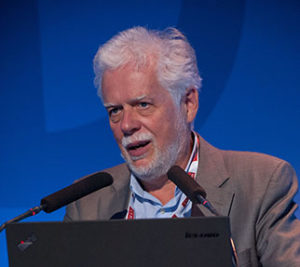
Ten-year outcomes from the randomised controlled EMMY trial were presented at CIRSE 2016 (10–14 September, Barcelona, Spain) by Jim Reekers, Academic Medical Center, Amsterdam, The Netherlands. The results have also been published in July 2016 in the American Journal of Obstetrics and Gynecology by de Bruijn AM and colleagues.
EMMY is a Dutch, randomised controlled trial that set out to compare the clinical outcome and health-related quality of life in patients treated with either uterine artery embolization or hysterectomy for heavy menstrual bleeding caused by uterine fibroids.
The 10-year results show that the majority, around two thirds, of patients undergoing uterine artery embolization can side-step having a hysterectomy. Around 35% who underwent embolization went on to have a secondary hysterectomy, with just over 30% of these being patients who had had a successful uterine artery embolization procedure. These long-term data further contribute to the picture of the minimally invasive option being beset by the need for reintervention for symptom recurrence and control. Reintervention was not part of the trial and was considered a failure.
“After 10-years of follow-up, about two thirds of patients with symptomatic uterine fibroids, who undergo treatment with embolization can avoid a hysterectomy,” Reekers said, commenting on the results. “Health-related quality of life at 10 years after uterine artery embolization or hysterectomy remain comparably stable. Uterine artery embolization is a well-documented and good alternative to hysterectomy for symptomatic uterine fibroids, on which all eligible patients should be counselled,” he added.
Uterine artery embolization has been described as an alternative treatment to hysterectomy for patients with symptomatic fibroids since 1995. However, one of the barriers to its widespread uptake has been that women who are eligible for this treatment are often not informed about it.
Speaking on this aspect, ie women not being informed about embolization, Robert Vogelzang, chief of vascular and interventional radiology, Northwestern Memorial Hospital, Chicago, USA and a past president of the Society of Interventional Radiology, said in April this year: “Sadly, the patients who have fibroids are often not being told about embolization.”
Reekers told Interventional News: “Not informing patients about uterine fibroid embolization, when these 10-year data are available, is unethical. Uterine fibroid embolization is an interventional radiology procedure that has level one evidence to back its use. In this trial, we treated the worst end-stage scenario without any reintervention, so real world outcomes for embolization will be even better.” Importantly, he emphasised, “Surgical reintervention in the hysterectomy group after 10 years run as high as 17%.”
In the EMMY trial, 28 Dutch hospitals recruited patients with symptomatic uterine fibroids who were eligible for hysterectomy. Patients were then randomly assigned in a 1:1 ratio to receive either uterine artery embolization or hysterectomy. The researchers randomised 177 patients from 2002 to 2004. Of these, 81 received uterine artery embolization and 75 underwent hysterectomy. Twenty one patients withdrew from the trial. The 10-year questionnaire was mailed when the last patient enrolled had been treated 10 years earlier.
At 10 years postintervention, the investigators assessed reintervention rates, health-related quality of life, and patient satisfaction, which were obtained through validated questionnaires. The study outcomes were analysed according to original treatment assignment on an intention to treat basis.
Questionnaires were received from 131 of 156 patients (84%). The mean duration of follow-up was 133 months. Ten years after treatment 28 of 81 (35%) had a secondary hysterectomy. Of these 24 out of 77 (31%) were after successful uterine artery embolization. The authors reported that secondary hysterectomies were performed for persistent symptoms in all cases but one, which was for a uterine prolapse.
De Bruijn AM and colleagues found that after the initial treatment, health-related quality of life improved significantly. “After 10 years, generic health-related quality of life remained stable, without differences between both groups. The urogenital distress inventory and the defecation distress inventory showed a decrease in both groups, without significant differences between study arms, but with a trend towards better outcome for uterine artery embolization. Satisfaction in both groups remained comparable. The majority of patients declared being very satisfied about the received treatment; 78% of the uterine artery embolization group vs. 87% in the hysterectomy group,” the authors write.












